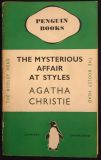Paperback books helped create my lifelong reading addiction, in large part because they were affordable. I have fond memories of a small bookstore in an alley behind the Post Office in my hometown. Although the location might suggest a bawdy stock, it was actually akin to the small bookstores we would later see in shopping malls. I would stop in a couple times a month and spend an inordinate amount of time looking through the store, particularly the spinning metal display stands. Paperbacks also had the advantage of fitting in your back pocket for hands-free transportation.
The modern paperback revolution began in Great Britain 81 years ago today when Penguin Books published its first 10 titles. In 1934, a former managing editor at The Bodley Head publishing house in London, Allen Lane, wanted to try publishing more affordable quality literature. His goal was sixpence (about 16 cents U.S. then), the cost of a packet of 10 cigarettes at the time. He and his brothers created the “Penguin Books” imprint and convinced Bodley Head to publish 20,000 copies each of 10 different titles.
 When the book trade placed orders for less than half that initial press run, Lane needed another market. He met with a buyer for Woolworth’s, then the largest chain store in the U.K. He left with an order for 36,000 books and by the end of the summer the chain’s purchases totaled 63,000 copies. Legend has it that the sale occurred because the buyer’s wife happened to walk in on the meeting. She saw Agatha Christie’s The Mysterious Affair at Styles among Lane’s books and told her husband that if books were a sixpence she would buy several a week.
When the book trade placed orders for less than half that initial press run, Lane needed another market. He met with a buyer for Woolworth’s, then the largest chain store in the U.K. He left with an order for 36,000 books and by the end of the summer the chain’s purchases totaled 63,000 copies. Legend has it that the sale occurred because the buyer’s wife happened to walk in on the meeting. She saw Agatha Christie’s The Mysterious Affair at Styles among Lane’s books and told her husband that if books were a sixpence she would buy several a week.
Penguin’s sales that year were so good that Allen established Penguin as a separate business in January 1936. By March, Penguin had printed 1 million books and it published its 100th title in June 1937. Much of the initial success was because the first 10 titles were previously published and fairly popular at the time. In order, they were:
- Ariel, André Maurois
- A Farewell to Arms, Ernest Hemingway
- Poet’s Pub, Eric Linklater
- Madame Claire, Susan Ertz
- The Unpleasantness at the Bellona Club, Dorothy L. Sayers
- The Mysterious Affair at Styles, Agatha Christie
- Twenty-five, Beverley Nichols
- William, E.H. Young
- Gone to Earth, Mary Webb
- Carnival, Compton Mackenzie
 Penguin’s book covers were basic. They had three horizontal bands, with the upper and lower bands color-coded according to genre. The top band said “Penguin Books,” the middle contained the title and author, and the bottom had a penguin logo. Initially, the cover colors were orange for general fiction, dark blue for biography, and green for crime fiction. As Penguin expanded its subjects, the colors included cerise for travel and adventure, yellow for miscellaneous, red for drama, purple for essays and belles-lettres, and grey for world affairs.
Penguin’s book covers were basic. They had three horizontal bands, with the upper and lower bands color-coded according to genre. The top band said “Penguin Books,” the middle contained the title and author, and the bottom had a penguin logo. Initially, the cover colors were orange for general fiction, dark blue for biography, and green for crime fiction. As Penguin expanded its subjects, the colors included cerise for travel and adventure, yellow for miscellaneous, red for drama, purple for essays and belles-lettres, and grey for world affairs.
Lane formed Penguin, Inc. in the U.S. in August 1939. A couple months before, though, Penguin’s success led to the creation of U.S.-based Pocket Books. In June 1939, Pocket published its first 10 titles at only 25 cents each, a tenth the cost of a hardcover book. By 1940, Americans bought 6 million paperback books, which would soar to more than 40 million in 1943. If that weren’t enough to create a nation of readers, between fall 1943 and fall 1947, American publishers gave U.S. soldiers and sailors 123 million paperbacks of 1,322 different titles in compact Armed Services Editions.
Penguin’s and Pocket’s paperbacks not only made book buying cheaper, books became available in grocery stores, drug stores or almost any retail establishment. Paperbacks remain widely available but affordability is again an issue. Today, most paperbacks are issued in trade editions. In 2014, the average price for a fiction trade paperback was $15.52; it was $20.15 for nonfiction. And while mass market paperbacks had an average price of $7.60, the 95 cents I spent for a paperback in 1973 is equivalent to $4.88 today. Keeping book reading strong may well hinge upon the ebook revolution.
We are the people of the book. …. There are teetering piles of books beside the bed and on the floor; there are masses of swollen paperbacks in the bathroom. Our books are us.
Cory Doctorow, “How to Destroy the Book”








Recently I’ve visited a clients home and admired a bookcase which she said had over 800 paperbacks. There is something special about a book you can hold and touch versus ebook but bad eyes bad lighting and the convienence of a book store where ever you are it is hard to beat